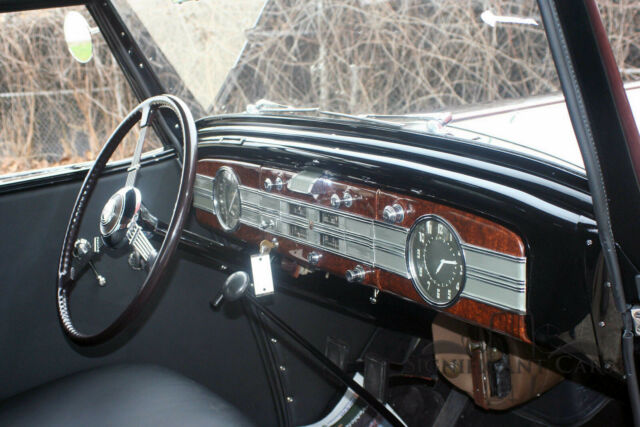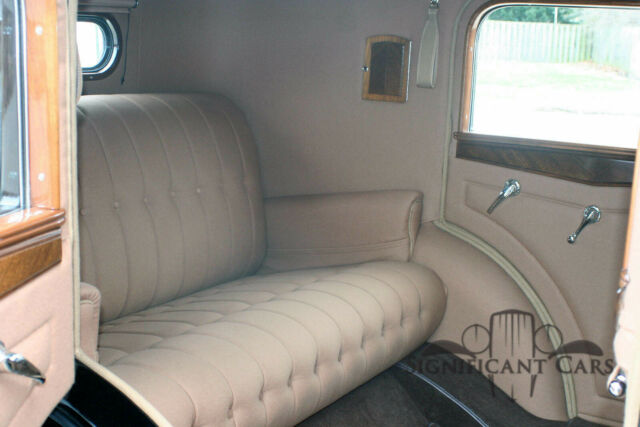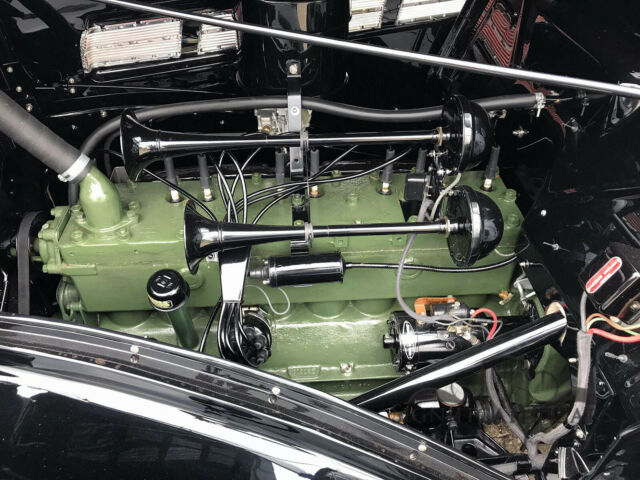1937 Packard 120 All Weather Cabriolet Rollston - 1 of 2! CCCA!
- Location: Indianapolis, Indiana, United States
- Condition: Used
- Make: Packard
- Model: Model 120 C
- SubModel: All Weather Cabriolet Rollston
- Type: Convertible
- Trim: All Weather Cabriolet
- Year: 1937
- Mileage: 25000
- Color: Black
- Engine size: Straight 8
- Number of cylinders: 8
- Transmission: Manual
- Drive type: 3 Speed
- Interior color: Gray
- Options: Convertible, Leather Seats
- Vehicle Title: Clear
1937 Packard Model 120 C All Weather Cabriolet Description
View our eBay StoreSign up for our Newsletter1937 Packard 120 All Weather Cabriolet by Rollston Offered as a buy-it-now. Make us an offer!
This exceptional example is one of only 2 built, and has a known history back to new. The car was purchased from the granddaughter of the original owner in up state New York, and treated to a ground up restoration by noted Packard expert John Greenleaf. The car has been shown selectively earning an AACA Senior Award, a CCCA Senior badge # 3067 scoring 100 points, and Best of Show and the Mayors Award at the National Packard Museum Meet. The quality of the restoration is quite impressive- this is a Spectacular Car.
The Junior Series Chassis is actually a more drivable car, particularly in urban settings, so its no surprise many famous and important customers opted for the 120 chassis in the late 30's. Rollston was one of the most respected coachbuilders of the time, and built this car to the same exacting and luxurious specifications as they would have on a larger Senior Chassis. The rear compartment is fitted with vanities complete with notebooks and smoking accessories, as well as an intercom for communication with the Chauffeur. The beautiful Broadcloth interior is plush and comfortable, has jump seats for additional passengers, and inlaid Walnut trim. The chauffeur's compartment is trimmed in Black Leather.
If you are looking for an award winnign car certain to be a standout at any event, look no further.
We have many more photographs of this car, please click on any image to be taken to our full-size image list!
Packard was founded by brothers James Ward Packar, William Doud Packard and his partner George Lewis Weiss in the city of Warren, OH. James Ward believed that they could build a better horseless carriage that the Winton cars owned by Weiss (An important Winton stockholder) and James Ward, himself a mechanical engineer, had some ideas how to improve on the designs of current automobiles. By 1899, they were building vehicles. The company, which they called the Ohio Automobile Company, quickly introduced a number of innovations in its designs, including the modern steering wheel and years later the first production 12-cylinder engine. While Ford was producing cars that sold for $440, the Packards concentrated on more upscale cars that started at $2,600. Packard automobiles developed a following not only in the United States, but also abroad, with many heads of state owning them. In need of more capital, the Packard brothers would find it when Henry Joy, a member of one of Detroit's oldest and wealthiest families, bought a Packard. Impressed by its reliability, he visited the Packards and soon enlisted a group of investors that included his brother-in-law, Truman Newberry. In 1902, Ohio Automobile Company became Packard Motor Car Company, with James as president. Packard moved its automobile operation to Detroit soon after and Joy became general manager and later chairman of the board.
The Packard'factory on East Grand Boulevard in Detroit was designed by Albert Kahn, and included the first use of reinforced concrete for industrial construction in Detroit. When opened in 1903, it was considered the most modern automobile manufacturing facility in the world and its skilled craftsmen practiced over eighty trades.The 3.5 million ft2 plant covered over 35 acres and straddled East Grand Boulevard. It was later subdivided by eighty-seven different companies. Kahn also designed The Pacakrd Proving Grounds at Utica, MI. Throughout the nineteen-tens and twenties, Packard built vehicles consistently were among the elite in luxury automobiles. The company was commonly referred to as being one of the "Three P's" of American motordom royalty, along with Pierce and Peerless. Packard's leadership of the luxury car field was supreme. Entering into the 1930s Packard attempted to beat the stock market crash and subsequent depression by manufacturing ever more opulent and expensive cars than it had prior to October 1929.
Packard did not change cars as often as other manufacturers did at the time. Rather than introducing new models annually, Packard began using its own "Series" formula for differentiating its model change-overs in 1923. New model series did not debut on a strictly annual basis, with some series lasting nearly two years, and others lasting as short a time as seven months. In the long run, though, Packard did average approximately one new series per year. By 1930, Packard automobiles were considered part of the "Seventh Series". By 1942, Packard was in its "Twentieth Series". There never was a "Thirteenth Series".
The '37 Packard is a legendary car, one of the most desirable of all years of Packard production with all the advancements of the time- independant front suspension and hydraulic brakes while still retaining the classic look of the earlier cars. Our Ebay Policies:
Significant Cars is one of the largest Collector Car Brokers and Dealers in the Country. Since 2003 we have worked hard to "change the way collector cars find new homes" by providing unparralleled web presentation of the cars we are representing. Most of our cars have over 30 photographs, and these can be viewed by visiting our website (our eBay handle dot com), or by clicking on any of the photographs in the black background area of our EBay listings. We welcome your call with any questions about any of our listings at anytime at 800-837-9902 and certainly encourage your personal inspection of any of the cars we are selling-just call us and we will be happy to set up an appointment for your to see and test drive the car.
We realize that eBay is a difficult venue to properly evaluate an item as complex as an automobile. You can feel secure bidding with confidence on any of our cars since we guarantee your satisfaction! Should you win the auction and come to see the car and decide you do not want it for any reason, no negative feedback will result, any deposit you may have paid will be cheerfully refunded.
Description images and copy © Significant Cars, Inc.
 1937 Packard Twelve LeBaron All Weather Cabriolet Town Car
1937 Packard Twelve LeBaron All Weather Cabriolet Town Car
Mileage: 230
 1936 Packard Twelve All Weather Cabriolet | 45+ years of single family ownership
1936 Packard Twelve All Weather Cabriolet | 45+ years of single family ownership
Mileage: 11,070
 PACKARD SERIES 120 1937 COUPE CABRIOLET
PACKARD SERIES 120 1937 COUPE CABRIOLET
Mileage: 5000
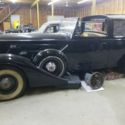 1937 PACKARD TWELVE LeBARON TOWN CABRIOLET
1937 PACKARD TWELVE LeBARON TOWN CABRIOLET
Mileage: 11111
 1937 Packard 115-C Coachbuilt Cabriolet by Graber | One of a few known to exist
1937 Packard 115-C Coachbuilt Cabriolet by Graber | One of a few known to exist
Mileage: 1111
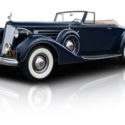 Frame Off Restored CCCA Senior 1 of 69 Packard Twelve 473 V12 3 Speed Manual
Frame Off Restored CCCA Senior 1 of 69 Packard Twelve 473 V12 3 Speed Manual
Mileage: 32,721
 1931 Packard Deluxe Eight Sport Phaeton | One of 97 built | CCCA eligible
1931 Packard Deluxe Eight Sport Phaeton | One of 97 built | CCCA eligible
Mileage: 1,939
 1941 Packard 160 Club Coupe, 97.5pt CCCA Senior, 83k mi, Tour or Show, Gorgeous!
1941 Packard 160 Club Coupe, 97.5pt CCCA Senior, 83k mi, Tour or Show, Gorgeous!
Mileage: 82,000
 1929 Packard Saloon 633 Sedan 8 Cylinder Great Driver Quality CCCA
1929 Packard Saloon 633 Sedan 8 Cylinder Great Driver Quality CCCA
Mileage: 100,000
 1936 Packard Twelve 1408 Convertible Sedan New Interior & Top CCCA Full Classic
1936 Packard Twelve 1408 Convertible Sedan New Interior & Top CCCA Full Classic
Mileage: 78,686








